Magazine
Juggernaut of Festivals

Let The Feasting Begin
Main Street, Flushing in Queens, New York had never had quite such a grand visitor before. Over the years, thousands of immigrants, not to mention politicians, celebrities and business tycoons, have milled through its boulevards – but here was Lord Ganesha Himself!
Clad in rich silks and laden with floral garlands, the beloved elephant-headed Hindu deity rode on a massive silver chariot pulled by silver horses past Indian grocery stores, Chinese take outs, halal shops and nail salons of Main Street. It was Ganesh Chaturthi, His birthday, and thousands had lined the street, as devotees danced to the beat of drums and clang of cymbals. The music could be heard blocks away. It was the largest birthday bash the borough of Queens has probably ever seen, celebrated for nine days at the Hindu Temple Society of North America in Flushing. Over 35,000 lunches were prepared; hundreds of pounds of sweets and hundreds of gallons of rose milk were distributed to devotees. Between 15,000-20,000 people turned up over the course of nine days at the temple to pray and participate in rituals, with devotees chanting the Moola mantra 400,000 times, morning and evening. Far from India, far from the womb of Hindu culture, this festival is now being celebrated across many cities in America – and it is just one of many Indian festivals resonating continents away from the homeland. There are so many temple celebrations that America could easily become a pilgrimage spot for Hindus! It has not always been that way. Two decades ago, many of the temples were in makeshift quarters or loaned premises ranging from a former mattress showroom in Northridge, Calif., to a YMCA in New Jersey. Today, the many large temples, including the towering Sri Venkateswara Temple in Pittsburgh, Penn., and the Chola style Meenakashi Temple in Texas, and the Ram Temple in Chicago, Ill., all throw elaborate festival bashes.
As Indians have thrived and prospered in America, their gods, their rituals and their festivals have also migrated to America. As we approach the season of festivals, it is no longer lonely for Indian immigrants. Along with Thanksgiving, Christmas and Hanukah, the festivals from the sub-continent – Navratri, Dusshera Diwali, Durga Puja and Eid, to name just a few – are also being celebrated on a grand scale. India is a land of a thousand festivals, including Sikh, Christian, Buddhist, Jewish and Islamic holy days, and many of them are echoing here. “There are rituals we bring from India and celebrate here, but sometimes in a condensed way, sometimes in a more elaborate way, and some we just jettison and some we modify,” says Dr. Vasudha Narayanan, Distinguished Professor of Religion at the University of Florida. “Whatever it is, we learn a lot from other Hindus from other parts of India in this country.” The festivals are undergoing a metamorphosis in the new land, transforming in subtle ways as migration necessitates adjustments and accommodations. The Grand Rath Yatra or chariot procession of Ganesha through Flushing, for instance, became Hinduism’s foray into the larger American community. “Lord Ganesha goes around the streets in the business area to bless all the people who were unable to come and get his grace,” says Dr. Uma Mysorekar, president of the Hindu temple in Flushing. “Practically the whole Flushing community turns up for this very large parade, so it also emphasizes the fact that it is not just a religious event, it is a community event and it brings thousands and thousands of people together.”
During the annual Rath Yatra, neighborhood stores handed out sodas and snacks to the huge crowds, including many non-Hindu Americans who watched the parade and strained for photos. In that interaction, it became an American experience, an American festival. In India, during the festival, thousands and thousands of images of Ganesha are finally submerged in the seas and the oceans. Here, because of environmental concerns, this was out of the question. So the temple’s clay Ganesha could not be submerged in a river or lake, but was immersed instead in a plastic swimming pool in the temple’s backyard. Once the clay melted into the water over a period of several days, the holy water was sprinkled on the lawn. Only in America! From Chicago and Atlanta to Los Angeles and Houston, massive temple complexes have sprouted up everywhere. The Hindu Temple of Atlanta, for instance, is not one but two temples on the same land. It houses both the Balaji Temple and a Shiva Temple, a reflection of unifying the needs of its varied population. It would be rare to find the two deities paired in India.
Dr. Ravi Sarma, vice president of the Hindu Temple, points out that many changes creep in during the process of migration to a new culture. While the Hindu Temple of Atlanta is orthodox and follows the traditions of South Indian temples with an emphasis on liturgy and stays true to the textual context, he says, many temples are devoted more to celebrations. The Atlanta Hindu Temple is able to stay purist, because it has 7 full time priests and adequate financial resources, which small isolated temples in rural areas may not have. The temple is open 24 hours, 365 days a week, which is rare even in India. He also points out that temples in this country are run by boards appointed by the congregations themselves, while in India even though the fundraising is done by devotees, the spending is controlled by different agencies, often governmental bodies, which run the temples. One big concession to the weekend concept in America is that large festivities are often organized on weekends to accommodate working families, instead of the actual day of the festival.
Interestingly, Sarma points out, that although 2,000 people turn up for major festivals like Diwali at the Hindu Temple, the event that draws the largest crowd, 6,000 strong, overrunning their car park, is not a religious one at all, but a secular celebration of New Year’s Day! “In the whole process of immigrant life, the festivals also begin to evolve in a different way,” says Madhulika Khandelwal, director of the Asian American Center at Queens College and an astute observer of the immigrant scene. “The overseas celebration of Indian festivals is shaped by various factors – who the community is, what kind of organization it is and what does it want to say by celebrating its festival.” Without a doubt, the biggest Indian festival celebrated by Indian immigrants in the United States is Diwali. It’s already being celebrated at the White House, it’s been given the special privilege of free parking in New York City and there is even talk of a Diwali stamp. And the final sign of arrival – a Diwali office party is being built into the script of an American prime time sitcom on TV!
But how festivals get to this rarified space, where they are recognized by the larger community is an intriguing story in itself, dependent on a number of factors, like political clout, PR smarts and community resources. For immigrants who came to the United States in the 1960s and 1970s, Diwali was a non-event, a very private affair, which the mainstream knew nothing about. There were few grocery stores, Indian restaurants and certainly no community centers. Friends would gather in homes, celebrating with homemade sweets. There were few temples and India seemed painfully far away during the holiday season. Smiti Khanna, a past president of Association of Indians in America (AIA), which organizes a huge Diwali Mela in South Street Seaport in Manhattan, first conceived of the festivities almost 20 years ago. She came to America as a 20-year-old in 1967, and recalls: “I’d left all my friends behind and I was lost for a while.” In those days there were no big scale Diwali celebrations in New York and the idea was to have a platform to bring the community together.
This public celebration, first started in 1987, was a way for Indian Americans to interact with the mainstream and also give a touch of Diwali festivities to nostalgic Indians and their American-born children. Today it’s a major event attended by thousands and with a fireworks display reputed to be second only to the Macy’s Fourth of July display in New York. But getting there has not been easy. The community was much smaller and there was little mainstream awareness of Diwali. Khanna recalls she once dressed up young dancers in ethnic costumes and took lighted diyas to the New York Times office to familiarize the newspaper with the festival and convince them to write about it! Now, of course, Diwali is written about frequently and the mainstream community is becoming familiar with it. The Jackson Heights Merchants Association organizes an annual street fair that transforms mundane 74th Street into a rousing neon-lit carnival, with eats, music and more. With the explosion of the desi population, there are also scores of dance parties and private card parties, all geared to Diwali celebrations as Little Indias all over from Artesia, Calif., to Atlanta, Ga., to Chicago, Ill., to Phoenix, Ariz. Mysorekar came to America 30 years ago. Ask her how the festivals have changed in the past three decades and she says, “Significantly. Earlier they were not celebrated on such a grand scale with so much participation. People have became more closely attracted to the temple since they could not celebrate their festivals in their homes and they have begun to come in large numbers to celebrate almost all the festivals at the temple.”
While most festivals are celebrated at home in India, where priests come and perform the puja and there is the bulwark of a large family, in the United States they are celebrated in the public space of the temple. Mysorekar points out that in India, rituals are performed at home and families visit the temple at the end of the day for “darshan,” but here the temple becomes the main stage for the festival. The biggest public celebrations are during Navratri, with multiple garba and dandiya raas parties, often featuring major dandiya performers flown in from India. In India the festivities run for 10 days, but in the United States they are restricted to three weekends, since everyone is working and no one has any domestic help. Raas Garba performances and celebrations are held in many venues from huge catering halls to high school auditoriums. Dance teachers, drummers, costume designers and stores all cater to this big passion. Disco dandiya and disco garba have become very popular with young Indian Americans and are the rage at Navratri celebrations. The celebrations run the gamut from performances in school auditoriums to big halls to the streets in India Square in Jersey City.
Pradeep Kothari was one of the pioneers of the big dandiya celebrations. He started in 1990 in a middle school auditorium in New Jersey, graduating to a high school space in 1991 and then in a large expo hall. For some years the Navratri celebration was held in a huge tent on leased land, with thousands coming for the big bash. It wasn’t all smooth sailing. In 1993 the town of Edison, N.J., insisted the event be closed by midnight as locals were complaining about the noise. “It was all politics and prejudice,” says Kothari. “There was no scientific proof about the noise. The nearest people were living two miles from the site, which was in an industrial area separated by a spaghetti of highways. People complained that their windows were rattling from the noise. If that kind of noise could be heard in their bedrooms two miles away, then the people at the event should have all gone deaf with the noise!” Kothari says the issue was settled out of court with lifetime permission to hold the function without any time restrictions. The town settled and paid $100,000 as a settlement fee, which was used to pay lawyers. This year, Kothari is holding the event under the auspices of India House for six days – three weekends at the Garden State Exhibition Center, and showcasing Sudesh Bhonsle. The space can accommodate 4,000 people and this time Kothari is introducing a novel concept not seen in traditional raas events – speed dating while being serenaded by Bhonsle. “The younger people are our main participants,” he says. “They have very different expectations. They want a very good sound system and well-organized place, without people pushing each other. I want to give a platform to young people. They make friends here and often even find life partners!” He adds, “Our celebrations are not only for Gujaratis, but open to all communities.” This pluralism is something that Narayanan has seen first-hand in the way festivals change in this country: The new traditions accommodate a new lifestyle. Growing up in South India, University of Florida’s Narayanan celebrated Navratri the way her grandmother did – as a women’s festival where even the invitation cards were in the names of the females. Only the women participated, visiting each other’s homes where huge alters of dolls were set up, a display of the goddesses of the nine nights, and singing classical songs dedicated to the Devi.
“That was the way it was celebrated in India when I was a child and I just loved it,” recalls Narayanan. “But here, when my second son was born, I thought, ‘Why should I wait for a daughter to be born to enjoy Navratri? I’m sure my sons will enjoy it too!’ When they were young, we started celebrating it and there were not too many families doing the celebrations. So people would come from all over north central Florida to my place to sing and soon the crowd became almost 150 people. But this included, because we are in this country, a celebration of men and women, so the gender issues become very different in this dynamic.” Also, in India several houses are visited in a night during Navratri, but here because of distances, people spend the entire afternoon and evening in one home, especially in places like Gainsville, Fl., where the community is smaller. Another change that Narayanan has noticed is the pan-Indian flavor to festivals here, with many regional communities joining. “I knew how to celebrate Navratri in India and that’s how I still celebrate it,” says Narayanan, who is from the South. “I had never seen the garba being performed until I came to this country. Here many of my friends are Gujarati so now we all do the garba. In any place where there’s a dominant group from a particular ethnic background in India and they are doing their festival, we join in that group and therefore it becomes a part of our way of celebrating.” The tone and volume of festivals also varies. In India, the day after Janmashtami or the birth of Krishna, is one of revelry, in keeping with Krishna’s fun-loving spirit. Clay pots of butter are suspended from poles on streets in towns like Mathura and Vrindaban, and even Mumbai. Bands of boisterous youth form human towers to get to the pots, mimicking Krishna’s exploits. To shouts of “Govinda Ala Re!” (Govinda is coming!) colored water is thrown on bystanders and participants. In America, this next day revelry is curtailed although there are huge celebrations of Janamashtami itself in the temples where multitudes gather around the crib of the newborn Krishna. Are we losing something here? “Many of our smaller regional festivals are less celebrated than our bigger ones, especially in smaller towns and here I think you have a direct co-relation between the size of the town, the number of Hindus and where they come from,” says Narayanan. “So in a place like New Jersey, you would have time for many different communities and many different festivals, but in a small town like Gainsville you celebrate those where people are from a certain tradition.”
Some festivals that are major in India, like Holi, the festival of colors, just do not seem to translate as well abroad. People don’t seem to have the avenues for the boisterous color throwing and dancing. In some places in India, Holi celebrations are held around a fire, which is a problem in public space in the United States. Some temples hold Holi events in parking lots, but on the whole this festival has simply not caught on, and is a pale imitation of the joyous celebrations in India, when just about anyone daring enough to be out on the streets is smeared with colored powder or drenched with a water-gun. How a festival gets transformed in migration can be seen in the way Holi has been retained by Indians who migrated to the Caribbean centuries ago. They no longer call it Holi. It is called Phagwa and is celebrated with all the joy and flamboyance a Holi celebration deserves. Says Khandelwal: “The Indo-Caribbeans have been trying to preserve these festivals for quite some time. Now when they bring these traditions to New York, they bring them with their own history. Phagwa is very important for them and has been celebrated for generations.” The Indian Caribbean community has brought its version of Holi to Richmond Hill, NY which is one of their prime concentrations. It is a huge festival and many South Asians also join in this very public festival where colors are thrown with abandon. Says Khandelwal, whose Indo-Caribbean friends inform her when Holi/Phagwa comes around: “If I was in India I would never have even known about phagwa. So it’s all about the context in which we are celebrating these festivals.” The large-scale celebration of Indian festivals also creates a venue for interaction with the larger community and is almost a symbol of arrival. Says Khandelwal, “Diwali has become very prominent. It’s become like a communication, an expression, an articulation of this community for other people.” Maroys, people from local government, senators and congressmen are invited to these festivities, and if they attend, it reflects well on the community’s clout. Mysorekar says that each year public officials are invited to temple celebrations: “It’s important for the temple and for us to show the world that we are together and we celebrate these festivals on a scale that is beyond comprehension,” she says. “And I think all these messages can be communicated to our own community plus to the outside community. The very fact that these officials are turning up shows they recognize and respect Hinduism as one of the major religions in the world today. Our contribution to global peace is very significant and all these congregations – no matter in which part of the world – only make it stronger.” So has the community really arrived? “Yes, we are becoming part of the mainstream in this country, and when local dignitaries and people from the government come, it kind of solidifies our presence here,” says Narayanan, who heads Chitra, the Center for the Study of Hindu Traditions at the University of Florida, the first such center in the country. “The idea of the center is to mainstream Hindu culture, like Jewish culture is in this country, as part of the academic curriculum.”
Narayanan says that Indian immigrants have adapted and adopted many American festivals too. She says, “There are different ways in which festivals take a new life in this country. For instance, we may join in with our larger American civil society and participate in what we call civil religion by observing things like graduation of students as a rite of passage or observing Mother’s Day. Interestingly enough, the celebration of these festivals is informed by our own Hindu sensibilities.” Mother’s day, for instance, is celebrated in many temples where mothers are honored in the context of Hindu text and heritage, when children recite “Matro deva Bhava” and young graduates are honored with passages from the Gayatri Upanishad. Says Narayanan, “We have seen Mother’s Day here and we recognize its value in the Hindu tradition in a very big way, so it’s a very natural and easy fit for us to celebrate not just Mother’s Day, but celebrate education by honoring graduates. These are new kinds of rituals or rites of passage that have entered the life of Hindus in this country.” The Internet is also playing a part in promoting the festivals and giving them a pan-Indian following. Raksha Bandhan was always a private festival celebrated largely in North India. Now thanks to the Internet, NRIs are trading electronic rakhis and gifts and are reminded of the festival by savvy e-businesses months in advance. In a new book Narayanan is authoring, she says: “In America temples frequently present a more unified version of Hinduism, but all the individual community groups and the diversity that they represent flourishes on the Internet.” Rathi Raja of Long Island, New York, is director of the Young Indian Culture Group. She has seen the community evolve over 25 years and says: “I think the celebration of a festival is a very personal thing and when kids are young you make a bigger deal of it. As a family matures, and your children go off to college your own personal life shifts.” She finds herself playing a larger role in the life of the community and in engaging the mainstream community. Last year she collaborated with the local library to do a six part series focused on Diwali – festival crafts, story telling and ended it with a food festival. They decorated the library floors with Rangoli, engaging non-Indians in a cultural conversation. As the Indian population has grown, it is more comfortable sharing their festival with others. She says, “It is definitely all a numbers game. You’re more comfortable when there are more like you. There are always the brave warriors, as I call them, people who 10-15 years ago were just individual parents in the classroom.” So have our festivals transformed for the better in the New World? “Certainly, no doubt about it,” says Mysorekar. “Temples are not just about worship. They are becoming platforms of social activity, including learning and education, helping juniors and seniors and addressing certain social problems like domestic violence and initiating health care programs. All these have become part of the temple.” She points out that many marriages take place at temples and people also find jobs from contacts they make at festive occasions. She says: “So I think it’s gone to become something beyond anyone’s imagination. None of these things happen in India. But here it happens and it happens for the good and it can only get better.” Indian festivals and Hindu rituals are also getting known to a wider, global audience through an unlikely preacher – Bollywood! So many non-Hindus now know about Karva Chaut, thanks to films like Dil Wale Dulhaniya Le Jayenge and Kabhi Khushi Kabhie Gham. The new Shahrukh Khan starrer Don has the Ganesh Chaturthi festival in it – and who can resist Shahrukh? “Bollywood picks up one festival as a sign of Indian culture and it becomes very popular because of the network of Bollywood and then it takes on a life of its own,” says Khandelwal. “Bollywood does play a major role in pushing some of these regional festivals and making them Indian festivals and to some extent, with international dimensions. People in Middle East will be watching these movies, and people in Russia would know all about Karva Chaut. It is strange – an intimate home festival and now the world knows about it!” Even major regional festivals like Durga Puja and Onam are finding space for celebrations within their communities with big and small events. Khandelwal believes the festivals we will hear more about will be the ones whose communities are cohesive and well organized. She points out that Gujaratis have had a Diaspora in Africa and the United Kingdom for at least two generations and so have experience in celebrating their festivals outside of India, and are a step ahead of the others. She finds the Sikh community also has a stronger awareness of the larger community in its celebrations of Baisakhi. Indeed, when the community in New York celebrated Baisakhi some years ago, a guest of honor was Mayor Bloomberg. “It’s not only that they have the experience of celebrating it, they decide to take it one level up,” Khandelwal says. “Many groups invite the mayor – where does he go? After 9/11, the Sikh community has really come together and has done a whole media campaign emphasizing who they are and why they should not be targeted. All this may have nothing to do with festivals, but it has an impact on how the festivals are perceived and recognized. So when the mayor comes, it’s not just a Sikh festival, it almost becomes a festival on the city calendar, on the mayor’s calendar.” Khandelwal notes about the Indian community in America, “It’s one ethnic group that is very diverse, but also takes its diversity very seriously. It doesn’t stop really with religion or region. Now, as they come here as immigrants and continue to function, many more smaller groups will be celebrating their festivals and looking at the American aspect. It’s beginning to happen already. There’s a hierarchy. Who can get the mayor and who can get City Hall and which will be a global event, and which will be a smaller event? So it is a mish-mash.” In the years ahead, the flurry of festivals will only grow. Add to this the fact that there are Hindus from all over the world in America – Sri Lanka, Nepal, Bangladesh and the Caribbean, and the celebrations become even larger. In fact, if we were to export all our festivals into the Diaspora with public holidays for all of them, 9 to 5 America would probably come to a standstill! Just this month California celebrated its first ever Kumbha Mela, that rare festival celebrated only once in 12 years in India. Titled the Confluence for World Peace, it took place on the eve of Sept 11 to invoke positive energy, and included the Vishwa Shanti Yagna, the Vedic fire ceremony to invoke peace. The huge celebration was held at the University of California Irvine’s Bren Center, co-ordinated by the Nithyananda Foundation, along with 18 organizations such as the Chinmaya Mission, Vedanta Society, Yogeesh Ashram, and the Hindu Swayamsevak Sangh. According to Ma Nithya Medhananda Mayi, an ashramite of the Nithyananda Ashram, the grand procession had 50 utsav murtis or deities from various temples and was led by spiritual leaders from several ashrams, temples and spiritual organizations: “This was almost like a two hour procession and it was a mile long, going along a two mile route. People were singing and dancing.” She adds, “There’s a recorded history of a thousand kumba melas being performed and all the great seekers and yogis have from time to time been invoking peace energies for the world – and that has never happened in any other part of the world or culture. We have replicated the whole process here.” The deities were immersed in a portable pond, which had water from 21 holy rivers in India gathered in it, and though the crowds couldn’t take a dip as they do in India, they sprinkled themselves with the blessed water. This famous festival takes place in four pilgrimage spots in India every 12 years. Now American chutzpah is creating its own version of it on its own schedule, but keeping the ideal confluence of the planets in mind. Who knows, soon Indian tourists may be undertaking pilgrimages to America to experience Indian festivals! |

.jpg)
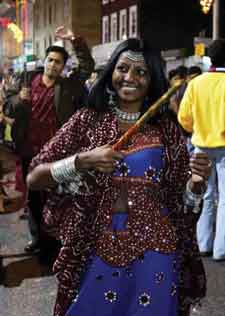
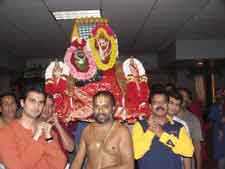
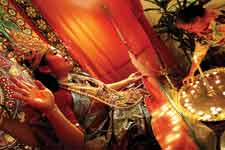
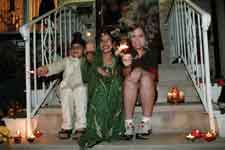
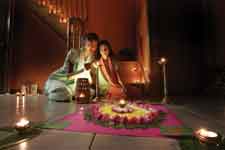
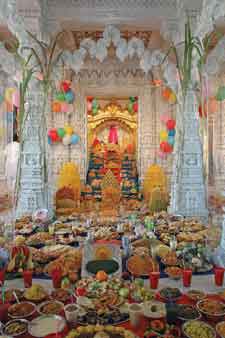
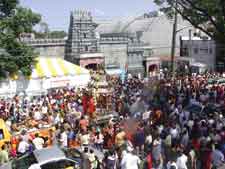
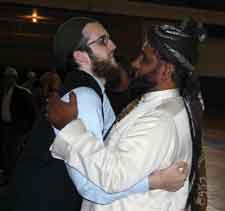
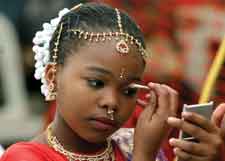
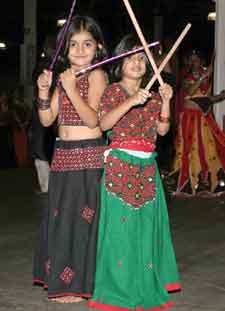
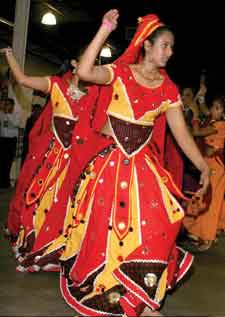
You must be logged in to post a comment Login